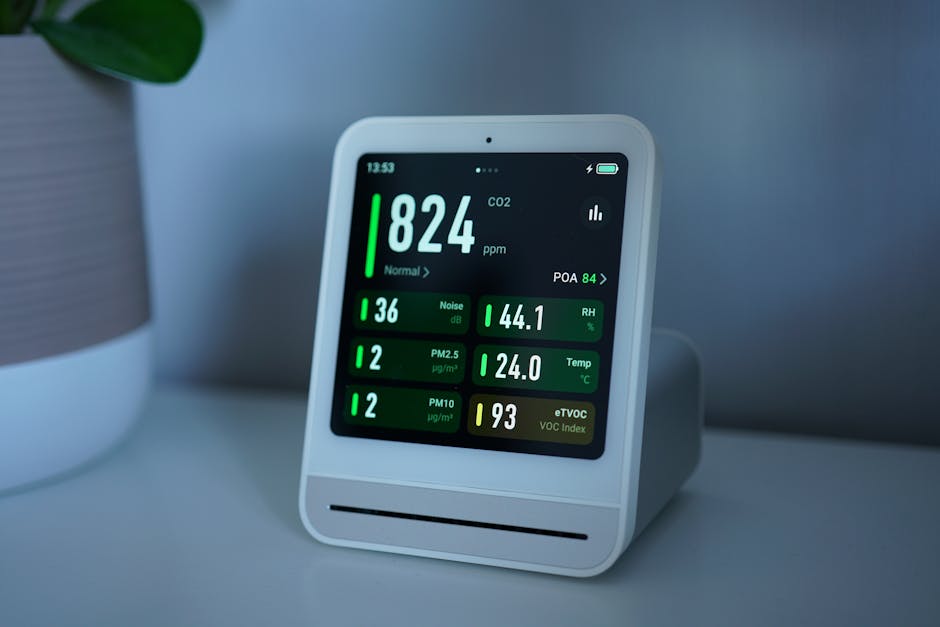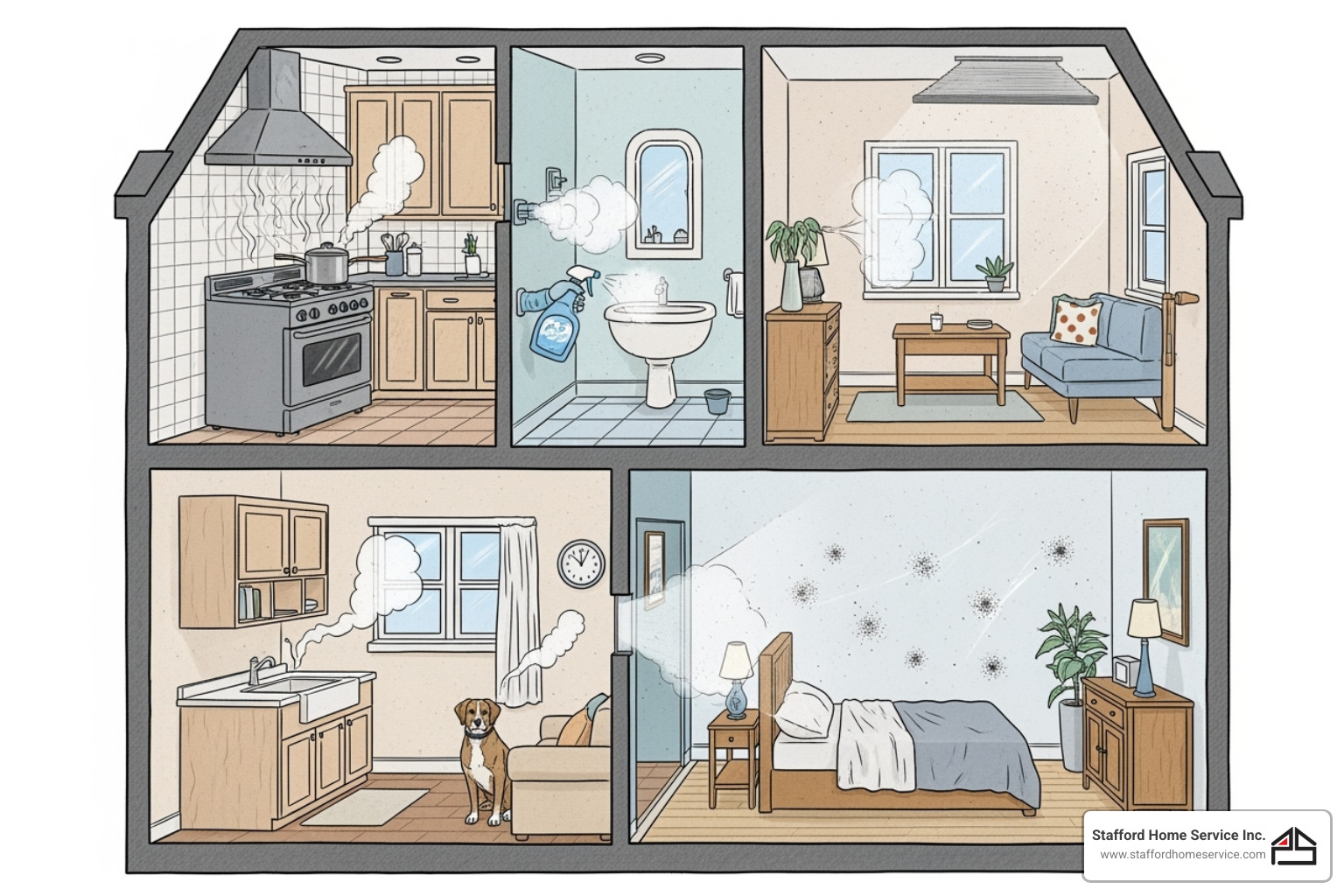Why Your Home’s Air Matters More Than You Think
Indoor air quality (IAQ) is the quality of air inside buildings, which directly impacts the health and comfort of occupants. Here are the key facts:
- We spend about 90% of our time indoors.
- Indoor air can be 2-5 times more polluted than outdoor air.
- Poor IAQ is linked to millions of deaths worldwide annually.
- Symptoms include headaches, fatigue, allergies, and respiratory issues.
- Key strategies for improvement are Source Control, Ventilation, and Filtration.
When you take a deep breath in your living room, you might assume the air is clean. After all, you’re inside, away from traffic and industrial pollution.
Not quite.
The reality is that the air circulating through your home could be harboring invisible threats. Dust mites, pet dander, volatile organic compounds (VOCs) from furniture, and even emissions from your gas stove can pollute the air you breathe.
For homeowners, poor IAQ affects family comfort, energy bills, and HVAC performance. The risks are even greater for children, the elderly, and those with asthma or allergies.
The good news? Understanding what’s in your air is the first step toward breathing easier.
The Hidden Sources: What’s Polluting Your Home’s Air?
The air inside your home can be more polluted than the air outside, containing an invisible mix of contaminants that affect your family’s health and comfort daily. Understanding indoor air quality is essential for every homeowner.
Pollutants fall into several categories: Biological contaminants like mold, dust mites, and pet dander; Chemical pollutants such as Volatile Organic Compounds (VOCs) from paints, furniture, and cleaning products; and Combustion pollutants like carbon monoxide from gas stoves and fireplaces. Even building materials and everyday household products can release harmful chemicals into your air.
Common Sources of Poor Indoor Air Quality
Let’s get specific about what’s polluting your home’s air.
Volatile Organic Compounds (VOCs) are gases released from paints, cleaning supplies, furniture, and air fresheners. That “new paint” smell is a sign of VOCs in your air.
Dust mites are microscopic creatures living in bedding and carpets. Their waste is a powerful and common allergen.
Your beloved pets contribute pet dander—tiny flakes of skin that become airborne and can trigger allergies.
Mold and mildew grow in damp areas like basements and bathrooms, releasing spores that can cause respiratory issues. Our guide on the Importance of Managing Indoor Humidity can help you prevent their growth.
Pollen enters your home on clothing and pets, settling on surfaces and becoming airborne when disturbed.
Tobacco smoke is a major pollutant, releasing hundreds of toxic chemicals that linger on surfaces long after smoking has stopped.
Your gas stove can be a major source of indoor pollution, emitting nitrogen dioxide, carbon monoxide, and harmful particles during cooking.
Many cleaning agents release VOCs and other irritants. Switching to eco-friendly alternatives can make a significant difference.
How Outdoor Factors Influence Your Indoor Air
Your home isn’t a sealed fortress; the air inside constantly interacts with the air outside.
Outdoor air pollution infiltration from vehicle exhaust, industry, and wildfires can seep into your home. During air quality alerts, it’s best to close windows and use your HVAC system.
Humidity levels outdoors directly affect indoor levels. High humidity encourages mold and dust mites, while low humidity can cause respiratory irritation.
Seasonal changes present unique challenges. Spring brings pollen, summer brings humidity, and winter traps pollutants indoors due to closed windows. Our articles on Springtime Tips for Indoor Air Quality and 4 Ways to Maintain Indoor Air Quality During Summer offer more advice.
Understanding these sources is the first step to improving your home’s air.
The Health Consequences of Breathing Contaminated Air
Poor indoor air quality is a serious health risk, linked to millions of deaths worldwide annually. While most indoor pollutants are invisible, your body feels their effects, which can range from minor irritation to life-threatening conditions.
Short-Term Health Effects
Short-term effects can appear quickly upon entering a building with poor air quality. Common symptoms include respiratory irritation (itchy eyes, nose, throat), headaches, fatigue, dizziness, and nausea.
For those with allergies or asthma, poor indoor air quality can trigger immediate flare-ups, causing coughing, sneezing, and shortness of breath. It can also lead to dry, itchy skin.
When these symptoms are tied to being in a specific building and improve upon leaving, it’s often called “Sick Building Syndrome.”
Long-Term Health Effects
While short-term effects are unpleasant, the long-term consequences of chronic exposure to indoor pollutants are more severe.
Chronic respiratory conditions can be caused or worsened by long-term exposure to pollutants like mold and particulate matter. This includes conditions like asthma and chronic bronchitis.
Cardiovascular disease has a direct link to indoor air pollution. Fine particulate matter from sources like gas stoves can enter the bloodstream, increasing the risk of heart attacks and strokes.
Certain pollutants like radon and formaldehyde are linked to an increased risk of cancer. Radon, a gas that seeps from the ground, is the second leading cause of lung cancer.
Ongoing exposure to irritants can worsen allergies and autoimmune disorders. Some chemicals can also impact neurological function, potentially leading to memory issues and reduced cognitive ability.
Vulnerable Populations and Specific Environments
Certain groups are more vulnerable to the effects of poor indoor air quality.
Children are especially at risk because they breathe more air relative to their size and their lungs are still developing. This makes them more susceptible to asthma and respiratory illnesses.
The elderly are also more vulnerable due to weaker immune systems and pre-existing health conditions.
Anyone with pre-existing health conditions like asthma, allergies, or heart disease will experience more severe symptoms from poor air quality.
Schools and workplaces are also critical environments. In schools, poor IAQ can impair students’ concentration and academic performance. For businesses, good IAQ improves productivity and reduces absenteeism. A healthy indoor environment is a critical factor for success in any setting. To learn more, read our article on The Importance of Indoor Air Quality in Schools.
The air we breathe indoors has measurable health effects. Understanding them is the first step toward protecting your family.
How to Test and Monitor Your Indoor Air Quality
Now that you know about potential pollutants, how do you find out what’s in your home’s air? Testing your indoor air quality is like a health checkup for your home. Fortunately, there are several accessible options, from DIY kits to professional assessments.
DIY Testing Methods
For many homeowners, DIY testing is a great starting point.
Indoor air quality monitors are widely available and track pollutants like particulate matter (PM2.5), VOCs, and carbon dioxide in real-time. They are great for general awareness but may not detect every specific pollutant.
Radon test kits are critical because radon is a dangerous, odorless gas and a leading cause of lung cancer. Simple DIY kits are the only way to detect it. You place the kit in your home for a set period and mail it to a lab for analysis. Health Canada radon exposure guidelines provide a reference for safe levels.
Mold test kits can help confirm the presence of mold, but results can be difficult to interpret. They are most useful when you already suspect a problem.
Carbon monoxide detectors are non-negotiable safety devices. Every home must have certified CO detectors on each floor and near sleeping areas, as CO is an invisible, odorless, and deadly gas.
Professional IAQ Assessment
For a comprehensive analysis, a professional indoor air quality assessment is best. Professionals use specialized equipment to identify a wide range of pollutants, pinpoint their sources, and provide customized solutions for your home.
When to Test
While regular monitoring is wise, certain situations call for immediate testing:
- Persistent Health Symptoms: If your family experiences ongoing headaches, allergies, or respiratory issues that improve when you leave the house.
- After Renovations: New building materials and furnishings can release high levels of VOCs.
- Unusual Odors or Visible Mold: These are clear signs that warrant investigation.
- After Water Damage: Leaks or flooding can lead to rapid mold growth.
- High-Radon Areas: If your region is known for high radon levels, testing is essential.
Interpreting Results and Latest Monitoring Technologies
Interpreting test results can be complex, which is a key benefit of professional assessments. Modern monitoring technology is also advancing, with smart devices that connect to your phone, integrate with home systems, and even offer portable options for personal tracking.
Addressing Specific, Dangerous Pollutants
Some pollutants require urgent attention due to severe health risks.
Carbon monoxide (CO) is a deadly gas that is undetectable without a certified detector. Install them on every floor and near bedrooms. Regular maintenance of combustion appliances like furnaces and gas stoves is also crucial to prevent leaks.
Radon seeps into homes from the ground. Testing is the only way to detect it. If levels are high, professional mitigation systems can effectively reduce them to safe levels.
Mold‘s best defense is moisture control. Fix leaks immediately, use exhaust fans in kitchens and bathrooms, and keep indoor humidity between 30-50%. Our article on the Importance of Bathroom Ventilation Fans explains more. Prevention is always better than remediation.
Testing and monitoring are investments in your family’s health, empowering you to take targeted action for cleaner air.
A Breath of Fresh Air: Your Guide to IAQ Improvement
Now that you can identify and detect indoor air threats, it’s time to take action. Improving your home’s indoor air quality relies on three core strategies: Source Control (eliminating pollutants), Ventilation (exchanging stale air for fresh), and Filtration (capturing airborne particles).
Your HVAC system is central to all three. Proper maintenance is essential for it to filter air, control humidity, and circulate fresh air effectively, as explained in our guide on how to Combat Allergies with Your HVAC System.
Strategies for Improving Your Home’s Indoor Air Quality
Here are practical ways to implement these core strategies.
Source Control Methods
The best way to improve IAQ is to eliminate pollutants at their source.
- Choose low-VOC products for paint, furniture, and cleaning supplies to reduce chemical off-gassing.
- Ventilate during activities like cooking or cleaning by opening a window or using an exhaust fan.
- Manage moisture by fixing leaks and using dehumidifiers in damp areas to keep humidity between 30-50%.
- Clean regularly with a damp cloth and a HEPA-filter vacuum to trap dust and allergens.
- Keep smoking outdoors, as there is no safe level of secondhand smoke inside.
- Store chemicals like paints and solvents in sealed containers in a well-ventilated area like a garage.
Improving Natural Ventilation
Using fresh outdoor air is a simple and effective way to improve IAQ.
- Open windows and doors for 15-20 minutes daily (when outdoor air quality is good) to flush out pollutants.
- Use exhaust fans in bathrooms and kitchens to remove moisture and cooking fumes. Ensure they vent outdoors. Our article on the Importance of Bathroom Ventilation Fans highlights their value.
- Promote airflow by keeping interior doors open to prevent stagnant air.
Mechanical Ventilation Solutions
Since modern, energy-efficient homes can trap pollutants, mechanical ventilation is often necessary.
- Air exchangers (HRVs and ERVs) provide a continuous supply of fresh, filtered air while expelling stale air. They recover energy from the outgoing air to treat the incoming air, saving on energy costs. Learn more about our Air Exchangers.
- Whole-house fans can quickly flush out stale air, especially on cooler evenings.
Humidity Management
Maintaining indoor humidity between 30-50% is crucial for health and comfort. Too dry, and it can irritate sinuses; too humid, and it encourages mold and dust mites.
- During dry seasons, humidifiers add moisture to the air. Whole-house Humidifiers that integrate with your HVAC system provide consistent comfort. Our guide on the Importance of Managing Indoor Humidity explains more.
- For homes with excess moisture, whole-house dehumidifiers work with your HVAC system to automatically maintain ideal humidity levels. See our Whole House Dehumidifiers for more information.
The Power of Air Filtration and Purification
Filtration and purification are your final line of defense, capturing any remaining airborne particles.
- Your HVAC air filter is your first defense. Filters are rated by MERV (Minimum Efficiency Reporting Value); a higher rating (MERV 8-13 is typical for homes) captures smaller particles. It’s crucial to choose a filter compatible with your system to avoid restricting airflow. Our Air Filters page can help.
- HEPA filters are the gold standard, capturing 99.97% of particles as small as 0.3 microns. They can be used in portable units or integrated into a whole-home system.
- Whole-home air cleaners work with your HVAC system to provide superior filtration, capturing ultra-fine particles that standard filters miss. Learn more about our Air Cleaners.
- UV light technology installed in your HVAC system destroys airborne biological contaminants like bacteria, viruses, and mold spores. Find the benefits of UV Lights.
- Over time, ducts accumulate dust and other pollutants. Professional Duct Cleaning removes this buildup, improving airflow and preventing contaminants from recirculating.
Improving your air is about progress, not perfection. Start with the strategies that best fit your home and family.
Frequently Asked Questions about Indoor Air Quality
Homeowners often have questions when they’re thinking about improving the air in their homes. These are some of the most common ones we hear:
Are air-purifying plants an effective solution for cleaning indoor air?
While houseplants are a nice addition to a home, they are not an effective solution for significant indoor air quality problems. The studies showing their benefits were conducted in sealed labs, and you would need an impractical number of plants to make a real difference in a typical home. Rely on mechanical filtration and ventilation for measurable results.
What is the difference between an air purifier and a humidifier?
These devices serve two distinct functions. An air purifier cleans the air by trapping pollutants like dust, pollen, and dander in filters. A humidifier adds moisture to dry air to improve comfort, especially in winter. An air purifier cleans the air, while a humidifier adds moisture to it. Both can be important for good indoor air quality.
How often should I change my HVAC air filter?
The standard “every three months” is just a guideline. How often you should change your filter depends on your home. If you have pets or family members with allergies, you may need to change it monthly. The best practice is to check your filter every month. If it looks dirty, replace it. A clogged filter not only fails to clean the air but also strains your HVAC system and increases energy costs. A clean filter is your first line of defense for good indoor air quality.
Conclusion
Understanding indoor air quality is a critical part of home maintenance. Since we spend about 90% of our time indoors, the air we breathe directly impacts our health.
The pollutants in your home—from VOCs and dust mites to mold—are real threats to your family’s health and comfort. The good news is that you now have the knowledge to address them.
By focusing on the three core strategies—Source Control, Ventilation, and Filtration—you can make a significant difference. Solutions range from simple habits like opening windows and using low-VOC products to installing advanced systems like whole-home air cleaners or air exchangers.
Your HVAC system is the key to a healthy home. At Stafford Home Service Inc., we specialize in helping Minneapolis homeowners achieve cleaner, healthier air. From professional IAQ assessments to advanced filtration and ventilation solutions, our experienced team provides quality workmanship backed by the Daikin Comfort Promise.
You don’t have to manage indoor air quality alone. Partner with us to create a healthier home for your family.
Take the first step toward healthier air with our professional HVAC services







